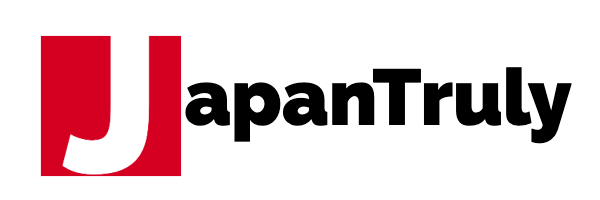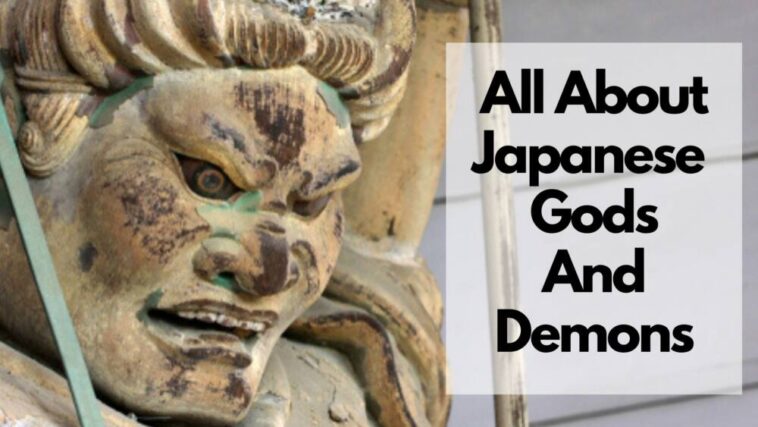Here’s a list of Japanese gods and demons you should know if you’re a fan of Japanese mythology and folklore. Check it out!
No matter what religion or culture you belong to, the concept of gods and demons is inculcated in us from an early age. We are taught that we live in a world of gods and monsters and we get to choose if we believe in them or not.
Japanese culture and tradition has given rise to many gods and goddesses as well as demons. Kami refers to the spirits, phenomena or “holy powers” that the Shinto religion of Japan has respected for many years.
The most popular name for demons in Japan is Yokai. In Japanese folklore, Yokai are strange, supernatural monsters, spirits and demons.

Oni is another name for demons as well. However, there are varying myths that suggest that oni is a type of yokai.
Yurie (ghosts) and oni have played a huge role in Japanese cultures and traditions. They are considered to be dangerous and not to be messed with.
Page Contents
List Of Japanese Gods And Demons
List of Japanese Gods
Amaterasu
Amaterasu or Amaterasu Omikami is the goddess of the sun. She is one of the most important Shinto gods. Ōhirume-no-muchi-no-kami or the great sun of kami is the ruler of the kami realm. It is believed that the Japanese imperial family descends from her.
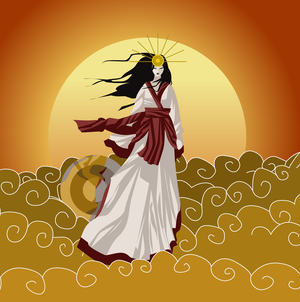
It is believed that she was born from the left eye of Izanagi when he washed away the underworld from his face after seeing his wife, Izanami, there.
One of the most popular stories about her is about her fight with her violent and ill tempered brother, Susano-O. After the fight, it is said that she fled and hid herself in a cave, This caused the whole world to be engulfed in darkness.
To bring her out, the other gods had a grand celebration at the entrance to lure her out.
When her curiosity got the best of her and she came out of the cave to see how the gods could entertain themselves in the absence of light, the gods placed a shimenawa or straw rope at the entrance of the cave. This was done so that she couldn’t go back into hiding.
The Ise Grand Shrine in the Mie Prefecture is her place of worship. It is also considered to be one of the most popular and significant Shinto shrines in Japan.
- Related: List of Japanese Dragons
- Related: List of Japanese Yokai
- Related: Yurei: Japanese Ghost Tales
Izanagi and Iznami
Also known as the mother and father of all gods, Izanagi no Mikoto and Izanami no Mikoto, are believed to have plunged a jeweled spear into the gulf between heaven and earth. They stirred the seas with the spear and the drops that fell from the tip of the spear created land.
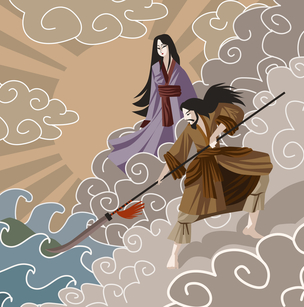
Izanami was burned to death when she gave birth to Kagutsuchi, the god of fire. Izanagi was so grieved by the death of his wife that he went to the Land of Death to bring her back.
But when he got there, he saw that she was nothing more than a rotting corpse that was being eaten away by maggots.
He was so repulsed by the sight that he fled and sealed the entrance. There she became the goddess of death and vowed to take a thousand lives a day as a way to avenge her humiliation.
To counter this, Izanagi decided that 1,500 people would be born every day.
Raijin and Fujin
They are often portrayed together with Raijin, the kami of lightning, thunder and storms, on the left and Fujin, the kami of wind, on the right.
Raijin is often seen holding a hammer and surrounded by drums. Fujin is seen holding a bag of wind and his hair flying wildly.
These gods of the weather are feared, yet highly respected. They are believed to be the cause of the kamikaze divine wind that help fight off the Mongols during their invasion in 1281.
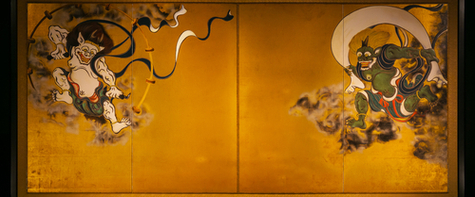
Kannon
Another important Buddhist deity of Japan, Kannon is known as the goddess of mercy and compassion. During the 17th century, when Christianity was banned in Japan, many used a depiction of Kannon holding a baby as a substitute for the Virgin Mary and Jesus.
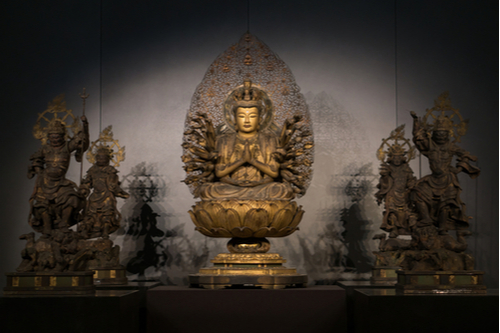
Kagutsuchi
Kagutsuchi, also known as Homusubi-no-kami or Hinokagutsuchi, is a mythological deity from Japanese folklore.
In Japanese mythology, Kagutsuchi is the god of fire and is associated with destructive volcanic eruptions.
The name “Kagutsuchi” translates to “incarnation of fire,” emphasizing the deity’s connection to flames and heat.
According to the ancient Japanese creation myth, Kagutsuchi was born during the birth of the fire god, Susanoo, who is the brother of Amaterasu, the sun goddess.
The myth recounts that when Susanoo was banished from heaven for his disruptive behavior, he tore through the celestial plains, causing a tumultuous and violent birth for Kagutsuchi.
As Kagutsuchi emerged, his fiery nature unleashed destruction and brought chaos to the world.
Tragically, Kagutsuchi’s birth caused the death of his mother, Izanami, the goddess of creation and death.
It is said that she was severely burned and succumbed to her injuries shortly after giving birth to Kagutsuchi.
This event deepened the rift between Susanoo and Amaterasu, as Amaterasu blamed her brother for their mother’s death.
Kagutsuchi’s destructive nature is further exemplified in another myth involving the god’s encounter with his sister, Amaterasu. In this story, Kagutsuchi visits Amaterasu in her heavenly palace, and the intense heat of his flames sets the palace on fire.
The terrified Amaterasu retreats into a cave, plunging the world into darkness and initiating a period of chaos and suffering.
It takes the combined efforts of the other gods and goddesses to lure Amaterasu out of the cave and restore light to the world.
Despite Kagutsuchi’s destructive tendencies, he is also recognized as a deity who brings renewal and transformation through fire.
Fire is seen as both a destructive and purifying force in Japanese mythology, capable of burning away impurities and enabling new growth.
Kagutsuchi’s association with fire makes him an important figure in rituals and ceremonies related to purification and renewal.
Overall, Kagutsuchi holds a prominent place in Japanese mythology as the god of fire, symbolizing the dual nature of destruction and purification.
His stories and symbolism highlight the power and significance of fire in Japanese culture and its role in both creation and destruction.
List Of Popular Japanese Demons
Oni
Oni has been one of the most popular characters in Japanese art, literature and theatre for centuries. They are known for their frightful appearance and depicted as large beings with horns.
They are usually blue, red or white in colour and wear loincloths of tiger pelt and carry large iron clubs.
These demons are believed to bring disaster, spread disease and punish sinners. Oni are born when an evil human dies and ends up in one of the many Buddhis hells. There, the Great Lord Enma, the ruler of hell, turns them into Oni.

Oni are known for their malevolence. They kill humans to entertain themselves and punish sinners by peeling off their skin, crushing their bones and other forms of torment.
In modern culture, Oni have lost their evil reputation. Instead they are used for protection and are believed to ward off bad luck. Onigawar or oni faced tiles are becoming a popular sight in Japanese buildings because it is believed to ward off evil.
Yamauba
Also known as the mountain ogress, Yamabau is believed to be old women who live in the mountains after being shunned by society.
They are known to have a taste for human flesh and most of the stories that revolve around them are those of them looking for humans to eat. One such story is of a yamauba providing shelter to a pregnant woman with plans of eating her baby after it was born.
Fun fact about them- they aren’t picky eaters and will eat anyone who passes them. They also have mouths under their hair. How delightful!
Tengu
Tengu are globlins that live in mountains and play tricks on people. They have been depicted in numerous folk tales and are said to be pure evil.
They are believed to lead people away from Buddhism, kidnap children and tie priests to talls towers and trees.
Legend has it that tengu were patients who were hypocrites and were sent to the mountains to live as goblins as a form of punishment.
To avoid falling victim to their tricks and mischief, people make offerings to them and have festivals dedicated to them.
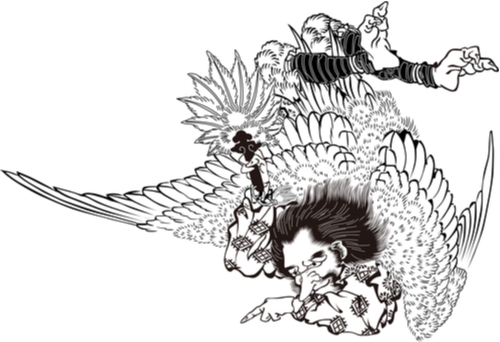
Kuchisake – Onna
Kuchisake-Onna, also known as the “Slit-Mouthed Woman,” is a legendary figure in Japanese folklore and urban legends. She is often depicted as a vengeful spirit or a malevolent yokai (supernatural creature).
According to the legend, Kuchisake-Onna was once a beautiful woman during the Heian period (794-1185) in Japan. However, her vanity and infidelity led to her husband’s anger and jealousy.
In a fit of rage, he disfigured her face by slitting her mouth from ear to ear, resulting in a grotesque and permanent smile. Unable to bear her new appearance, she took her own life.
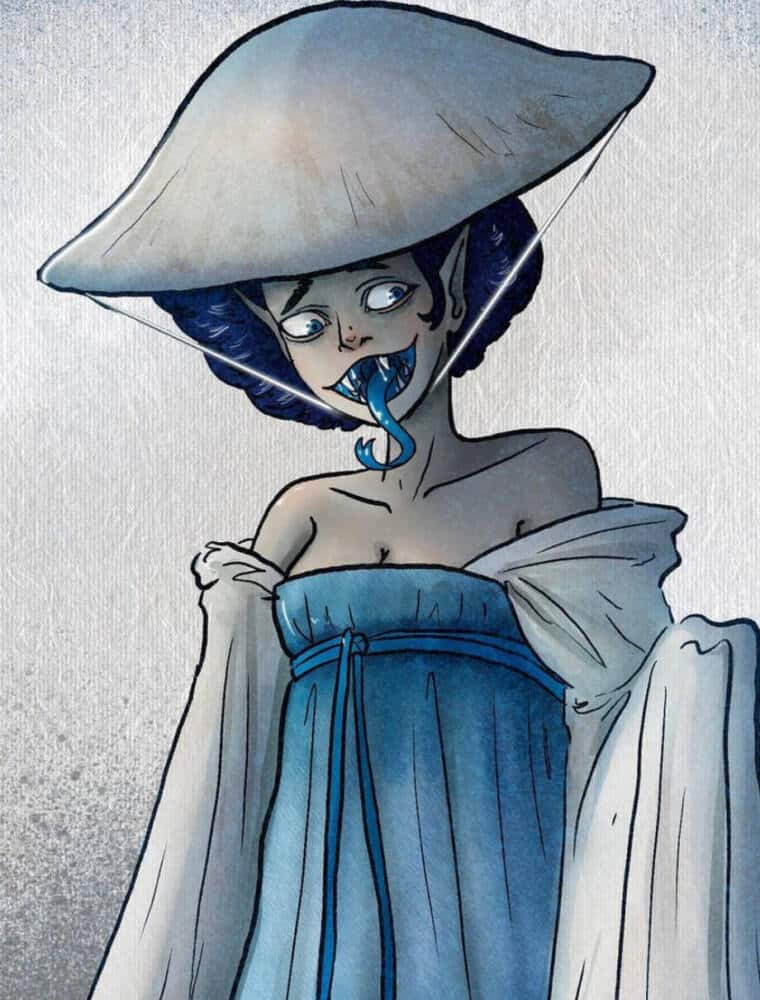
After death, Kuchisake-Onna’s spirit is said to have returned, haunting the streets of Japan.
She is often described as wearing a surgical mask or a cloth covering her face, which she uses to hide her disfigurement.
She is said to roam at night, targeting individuals, usually children or young people, who are alone.
Kuchisake-Onna approaches her victims and asks a question, typically in a friendly voice, such as “Am I pretty?” or “Do you think I’m beautiful?” If the person answers “no,” she reveals her disfigured mouth, brandishing a large pair of scissors, and kills them on the spot.
If the person answers “yes,” she removes her mask, revealing her horrific smile, and asks the same question again. If the person answers “no” the second time, they are spared but will be followed by her. If they answer “yes” again, she will slice their mouth to resemble hers.
In some versions of the legend, there are ways to escape Kuchisake-Onna’s wrath. These include giving vague answers, distracting her, or confusing her with other questions or objects.
Some stories suggest showing her a gold object or offering her a piece of candy to buy enough time to escape.
The legend of Kuchisake-Onna has become a popular urban legend in Japan, inspiring various adaptations in books, movies, and other forms of media.
It serves as a cautionary tale and has gained widespread recognition both within and outside of Japan.
Kiyohime
Kiyohime is a popular character from Japanese folklore, often associated with the tale of the “Yotsuya Kaidan” or “The Ghost Story of Yotsuya.” Her story has been adapted into various forms of art and literature, including kabuki and films.
Kiyohime’s story revolves around her unrequited love for a young samurai named Anchin.
According to the legend, Kiyohime was a beautiful young woman who fell in love with Anchin when he sought refuge at her father’s temple. However, Anchin was not interested in Kiyohime and rejected her advances.
Heartbroken and consumed by jealousy, Kiyohime transformed into a terrifying serpent, fueled by her intense emotions. With her newfound form, she pursued Anchin, who tried to escape her wrath.
Kiyohime chased him through various locations, including a river, a bell tower, and finally, a temple. She destroyed everything in her path, seeking revenge for her unrequited love.
In some versions of the story, Kiyohime’s pursuit ends tragically, resulting in the death of both Anchin and herself.
In other versions, Anchin manages to find refuge in a temple bell, and Kiyohime’s rage causes her to coil around the bell, eventually suffocating and killing him.
Kiyohime’s tale is often seen as a cautionary story about the consequences of unrequited love and the destructive power of jealousy.
It highlights themes of obsession, vengeance, and the transformative nature of intense emotions.
Kiyohime has become an iconic figure in Japanese folklore and has been depicted in various forms of art, such as ukiyo-e prints and contemporary illustrations.
She is often depicted as a beautiful young woman with long, flowing hair, accompanied by a coiled serpent or in her full serpent form, with fiery eyes and a menacing appearance.
It’s worth noting that Kiyohime’s story has also been adapted and incorporated into different works of popular culture, such as anime, manga, and video games, further cementing her status as a memorable character in Japanese folklore.
Agi Bridge Demon
he Agi Bridge Demon is a character in a collection of Japanese folktales known as setsuwa. The stories in this collection were originally told orally, and were later written down in anthologies compiled between the 9th and 13th centuries.
The story of the Agi Bridge Demon is about a monk who is traveling to the capital city of Kyoto. On his way, he comes to a bridge called Agi Bridge. As he is crossing the bridge, he sees a beautiful woman sitting on the other side.
The woman beckons to him, and he is drawn to her. However, as he gets closer, he realizes that the woman is actually a hideous demon.
The demon tries to attack him, but the monk is able to escape.
The story of the Agi Bridge Demon is a warning about the dangers of temptation. The beautiful woman is a lure, and the monk who succumbs to her will be punished.
The story also reflects the Japanese belief in the supernatural. In Japanese folklore, demons are often depicted as beautiful creatures who disguise their true nature in order to lure unsuspecting victims.
The Agi Bridge Demon is a popular character in Japanese culture. He has been featured in kabuki plays, novels, and films. He is also a popular subject of Japanese art.
The Agi Bridge Demon is a reminder of the dangers of temptation and the power of the supernatural.
Shuten Doji
Shuten Dōji, also known as Shuten-dōji or Shuten-doji, is a legendary creature from Japanese folklore.
The name “Shuten Dōji” can be translated as “drunken demon child” or “drunken little demon.” It is often depicted as a powerful and fearsome oni or demon.
According to the legends, Shuten Dōji was the leader of a group of oni who terrorized the area around Mount Oe during the Heian period (794-1185) in Japan.
The creature was said to have the ability to shape-shift and could take on various forms, including that of a giant, a human, or even a small child.
Shuten Dōji was known for its love of sake and would often hold wild parties where humans would be kidnapped and brought to the mountain to be feasted upon.
One of the most famous tales involving Shuten Dōji is the story of the warrior Minamoto no Raikō and his group of warriors known as the “Four Heavenly Kings.”
They were tasked with defeating the demon and putting an end to its reign of terror. After a fierce battle, Raikō and his men were able to slay Shuten Dōji, and the demon’s head was displayed as proof of their victory.
Shuten Dōji has been depicted in various forms of Japanese literature, theater, and art over the centuries.
The creature is often portrayed as a fearsome and imposing figure with horns, fangs, and a large, muscular body. Its association with drunkenness and wild parties has made it a popular subject in traditional Japanese folklore and entertainment.
It’s important to note that Shuten Dōji is a mythical character from folklore and does not have a basis in historical fact.
The stories surrounding Shuten Dōji have been passed down through oral tradition and various written accounts, contributing to its enduring popularity in Japanese culture.
What are kami?
Kami has been used to describe the mind, God, supreme being, an effigy, and anything that is worshipped. In ancient traditions, the following were believe to be the defining characteristics of kami:
- Kami are of two minds: When respected, they can be nurturing and loving’ but when disregarded, they can bring destruction and discord. They have two souls- nigi-mitama or the gentle one and ara-mitama or the assertive one. In Yamakage Shinto, kami have an additional two souls that they hide- saki-mitama or the happy one and kushi-mitama or the mysterious one.
- Kami are hidden to the human realm. They live in sacred places, natural phenomena, or people during rituals that seek their blessings.
- They move around and visit their places of worship but they don’t stick around for too long.
- There are three hundred different varieties of kami mentioned in the Kojiki and they all have different jobs.
- All kami have different duties that they need to perform. They have specific functions that they are obligated to fulfil.

In Shinto it is believed that kami are not separate from nature. Instead, they are elements of nature that can have good or evil characters. They can be aspects of a landscape, forces of nature, or characteristics that these beings express. They can also be the spirits of respected people who have passed.
It is also believed that many kami come from ancient clans when the ancestor passes away and are able to embody the values and virtues of kami during their life. Great leaders like the Emperor can be or become kami.
Kami are said to be manifestations of mususbi, which is the interconnecting energy of the universe. Kami are considered to be the highest form of what humans should aim for.
Kami are hidden in our world and have a complementary existence that is a mirror of our world. This is called shinkai or the world of kami. Kannagara no michi or the way of the kami is to be in harmony with all aspects of nature.
What are Yokai?
Yokai are not the easiest to describe and define. They can be demons, apparitions or animal like creatures. Some even resemble inanimate objects.
They have supernatural abilities, out of which the most common is shapeshifting. Yokai that can shapeshift are called Bakemono or Obake.
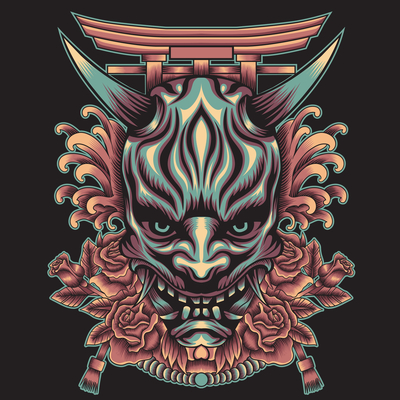
There are many stories and depictions of Yokai in Japanese art, literature and theatre. Some are portrayed as scary and malicious, while some are timid and don’t cause harm.
List of Japanese Gods and Demons: FAQs
What do Japanese call demons?
The most common Japanese name for demons is Yokai and Oni.
What do Japanese call gods?
The Japanese word for god is Kami.
What is the strongest Japanese demon?
Shuten-doji is considered to be the strongest Oni in Japan.
How many Japanese gods are there?
There are eight million kami. This is a number that is used synonymously with infinity in the Japanese culture.
Who was the first Japanese god?
The first gods in Japanese mythology were Amenominakanushi, Takamimusubi, and Kamimusubi.
